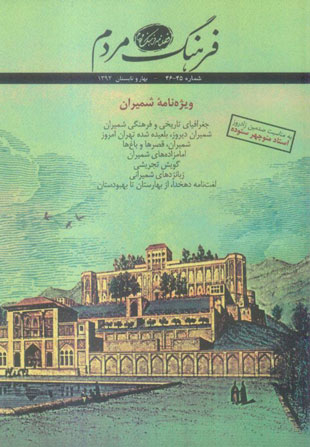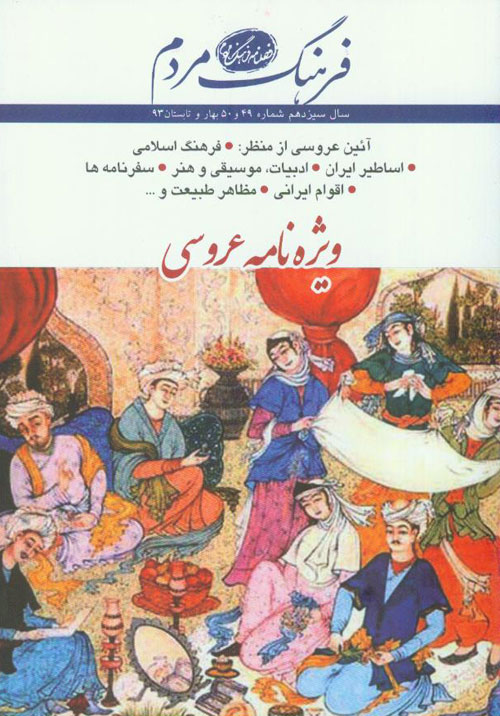فهرست مطالب

فصلنامه فرهنگ مردم
پیاپی 45-46 (بهار و تابستان 1392)
- تاریخ انتشار: 1392/06/15
- تعداد عناوین: 24
-
صفحه 3
-
صفحه 16
-
صفحه 41
-
صفحه 73
-
صفحه 77
-
صفحه 87
-
صفحه 108
-
صفحه 113
-
صفحه 124
-
صفحه 140
-
صفحه 144
-
صفحه 153
-
صفحه 157
-
صفحه 165
-
صفحه 192
-
صفحه 194
-
صفحه 200
-
صفحه 205
-
صفحه 208
-
Page 6Alborz mountains in the north of Rey and Tehran, lexically consists of “har” with the meaning of mountain and “borz” with the meaning of high with beautiful nature and water, gave birth to civilization of Rey and Tehran. Culture of this area developed by archeological discoveries date back to 3000 years ago, and “Ghasran” and “Shemiran” became important. The importance of Shemiran increased from Safavid and then Qajar period, after Tehran was chosen as capital city of Iran. It made Shemiran as a destination for politicians and rich people, therefore resulted in destroying the nature.
-
Page 16Tehran started developing in Qajar dynasty. In 49 years of Nasser al-Din shah kingdom, Tehran owned twelve beautiful gates. In the First Pahlavi Era, the gates were destroyed and major parts of suburb joined the city. By emerging automobile and consequently completion the rest of Shemiran road-later called Shari’ati street-from Gholhak to Tajrish, and Pahlavi road-later called Vali’asr street-Tehran’s growth increased. In the Second Pahlavi Era, not only villages, but also the mountains were destroyed and Tehran developed to Rey in the south, and Tajrish countryside in the north. The rich people and foreigners moved to the good climate area of Shemiran and started building houses in different styles, whether eye-catching or ugly. Native people of Shemiran used to live in rural houses; but Shemiran was designated to be a rich neighborhood; that’s why the buildings left from Qajar period are all palaces, and from Pahlavi Era are modern villas by European architects, and it continues to the present with building complexes and skyscrapers.
-
Page 41Two mountains, Alborz and Zagros, one in the north and other in the west, are the most important high mountains of Iran. In contrast to Zagros, Alborz consists of high mounts, whith mount Damavand as the highest. Mountain climbers have always tried to discover new routes for high mounts climbing. This article aims to introduce the most important routes for climbing mount Damavand, Tochal, etc. and the routes for hiking from Tehran to the north through Alborz.
-
Page 47Shemiran-or according to Qajar Geographers “Shemiran village” - was a pleasant countryside for overheated Tehran. During hot summers, people, whether rich or poor, moved to Shemiran for days or months and were welcomed according to their wealth. This process continued for years, or even centuries, without overlapping the roles of Tehran and Shemiran as city and countryside. From 1310 SH, following the moats around Tehran were filled in, the villages were swallowed up as city - Tehran - expanded into the countryside of Tehran and later Shemiran. Consequently it replaced clean air of Tochal with toxic and hazardous air, and resulted in cutting shadowy and fruit trees for building ugly apartments. This article aims to describe how modernity destroyed the villages of Shemiran.
-
Page 73Emamzadeh Saleh is one of holy shrines of Shemiran located in Tajrish which is respected by people. He is one of the grand sons of Emam Mousa Kazem. There was high and eye-catching plane tree near this place and was referred in most travel accounts; Markopoulos in 700 years ago, for instance. Unfortunately it got burned by fire in recent years. This article also aims to compare this shrine with one of the churches of Rome as a lesson for Iranians who were at the top of culture and art long time ago.
-
Page 77There are dozens of holy shrines in Shemiran, but Emamzadeh Ghassem is of great importance among others. His tomb is in a village as the same title as him, near Golab Darreh at the top of Zahir al-Doleh cemetery. This article surveys this holy shrine in details, according to the documents of association of cultural figures. The most ancient part of its building dates back to Dailamian period, and up to now it has been reconstructed for several times. Its apron includes tombs of religious and cultural figures.
-
Page 83One of the holy shrines –Emamzadeh- of Shemiran was Emamzadeh Chenar located in Darband Street, Tajrish. Near this place, there was the cemetery of Tajrish which turned into a park by Reza Shah, and later changed function to a hospital –Shohada hospital. This article describes the story of this Emamzadeh.
-
Page 87Shemiran was a rural area in Alborz Mountains In the north of Tehran. This area consisted of 70 villages, i.e. Pas ghal’e, Emamzadeh Ghassem, Jamaran in the north, and Vanak, Gholhak, Darrus in the south. In the west were Farahzad and Poonak, and Sohanak, Lavizan and Narmak in the East. Shemirani dialect belongs to the Western Iranian Languages and used to be spoken in all villages of this area, with a difference in suprasegmentals. It was so close to the dialect of Roodbar Ghasran area. Because of the geographical proximity to Tehran, and temporary or permanent residence of people of Tehran in Shemiran, the dialect of Tehran influenced on Shemiran and it disappeared gradually; although some phonological and lexical elements are still left among native people. It is difficult for the researcher to identify what amounts of these elements are original or under influence of dominant Persian spoken in Tehran.
-
Page 108During last two centuries, the language, dialects, proverbs, tales, rituals and memories of Shemiran disappeared alongside with its natural sceneries. In a survey about proverbs, only a few proverbs of Tehran and Shemiran were found in a book titled “Ghand o Namak” by Jafar Shahri. Some of them are similar to other areas of Iran.
-
Page 140Darrus, previously was a small village in eastern north of Tehran with a population of around 500. Now, it is one of the richest neighborhoods and is accessible from all parts of Tehran. Signs of ancient civilizations were discovered in Darrus and found historical objects are kept in national museum of Iran. Darrus was possessed by Haj Mirza Aghasi in Qajar period, and later mokhber - al - saltane Hedayat bought it, resided there and built hospital and high school at this neighborhood. This article describes Darrus in the past and present.
-
Page 165Travel accounts which point to Tehran or Shemiran, are good reason to study natural, social and political history of an important area of the capital city; although mountain Alborz or even mount Damavand were not neglected as a symbol for the hole capital city in travel accounts and researches of Iranian and foreigner scholars.
-
Page 194The idea of Dehkhoda dictionary dates back to the First World War, when was in jail in Bakhtiari. Dehkhoda started this project by translating French dictionary to Persian, and prepared two million notes with the help of Dr. Ali Akbar Siassi. At the beginning, financial problems caused the book - Amsal o Hekam- to be published in 4 volumes; later with the limited patronage of parliament and selling his personal house, Dehkhoda finished the dictionary.Compiling the dictionary started from Baharestan, and moved to Baagh Ferdows in 1354 - part of Afshar’s suppressions. The dictionary finished in 9 volumes, there.
-
Page 200Loghatnameh Dehkhoda Institute & international Center for Persian Studies is one of the research institutes of Tehran university located in moghufat Afshar, Zaferaniyeh. The activities of this institute are divided into two parts: first is to compile Persian dictionary - Loghatnameh Bozorg Farsi- which is a descriptive dictionary started from 1360 after Dehkhodad dictionary. The alphabet “alef’, and a part of “be” have been published so far. The second part is teaching Persian language to foreigner students from elementary to advanced levels, and preparing main and supplementary books for them.


